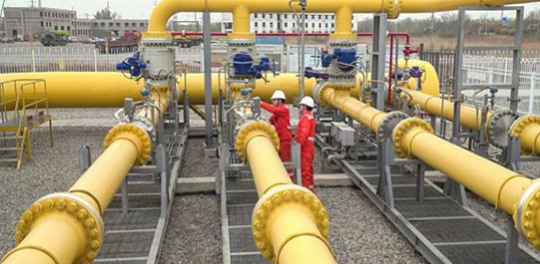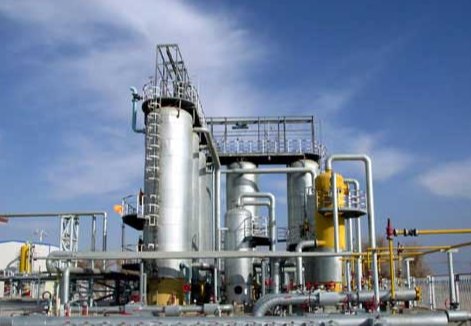The positioning and development path of natural gas power generation in the energy transition period
In the context of carbon peaking in 2030 and carbon neutrality in 2060, the task of China's energy transformation has been very clear, that is, the energy structure should be further adjusted and developed towards clean development. According to estimates, to achieve the goal of carbon neutrality in China, the proportion of renewable energy on the energy supply side should not be less than 80%, and the electrification rate on the demand side should not be less than 80%[1]. Carbon neutrality is the ultimate goal in the long term, but the main goal in the near term should be to achieve a rapid peak or even decline in total carbon emissions through reliable and effective emission reduction means, and reduce the pressure brought about by achieving carbon neutrality in the future.
The power industry is one of the important sources of carbon emission and pollutant emission, among which thermal power is the biggest emitter. Natural gas power generation (or "gas power generation" or "gas power") in thermal power has been paid attention to by developed countries because of its cleanliness, environmental protection and flexibility. To replace coal power generation with natural gas power generation (or "coal-fired power generation" and "coal power"), gradually control coal consumption, on the one hand, can reduce pollutant emissions and improve air quality; On the other hand, it can reduce the carbon emission intensity of the power industry, so that the total carbon emission is controlled, or even significantly reduced.
Compared with the development path of the natural gas industry in developed countries, the consumption growth momentum after the natural gas market enters the mature stage is mainly from power generation. In order to achieve the target of 15% natural gas in primary energy consumption by 2030 [2], the large-scale development of natural gas power generation is the key, especially the new generation of power systems with large-scale and high proportion of renewable energy, which puts forward higher requirements for the flexibility, safety and controllability of the power system. The clean, low-carbon and flexible nature of natural gas power generation will play an active role in the construction of a power system dominated by renewable energy.
In 2019, China's apparent consumption of natural gas was 306.7 billion m3, accounting for about 8.3% of the primary energy consumption structure, much lower than the global average of 24%. Among them, power generation gas 55.39 billion m3, accounting for 18.1%, less than half of the global average of 39%; These two indicators are far from developed countries such as the United States, the United Kingdom and Japan [3-4].

This paper analyzes the important role of gas power generation in energy transformation and its advantages in environmental protection, cleanliness and flexibility compared with coal power generation, analyzes the current problems faced by gas power generation, and puts forward the positioning and development path of natural gas power generation in the future power and energy structure.
1. Gas-fired power generation plays an obvious role in energy transformation
From international experience, in the next decade, while China is promoting renewable energy power generation, there is still room for the proportion of natural gas power generation to rise. From the experience of decarbonization in energy development in Germany and the United States, while reducing the proportion of coal consumption in primary energy and increasing the proportion of renewable energy, natural gas consumption has still increased. In Germany, the proportion of coal in primary energy consumption was relatively high before 1995, reaching 41.32% in 1985, and then the use of coal and the proportion in primary energy consumption decreased rapidly, falling to 21.27% in 2017. After 2011, as the proportion of nuclear energy declined, the proportion of renewable energy such as wind energy, light energy and biological energy rose rapidly, and natural gas accounted for about 23.4% of Germany's primary energy consumption in 2018, more than coal. In 2019, the German government decided to phase out the use of coal by 2038. According to its latest "energy transition" plan, by 2030, the proportion of renewable energy generation in Germany needs to reach 65%, natural gas power generation accounted for about 18%, and carbon emissions need to be reduced by 55% compared with 1990. In the proportion of primary energy consumption in the United States, oil, natural gas and coal are absolutely dominant, maintaining more than 80% for a long time. In 2019, the share of renewable energy consumption in the United States reached 11.5%, surpassing coal for the first time in more than 130 years. At the same time, natural gas consumption reached a new high, accounting for about 32%, with the increase mainly coming from gas-fired power generation. Compared with Germany and the United States, coal accounted for 57.7% of China's primary energy in 2019, and natural gas accounted for only 8.3%. According to international experience, in the rapid development of renewable energy, natural gas, as an important transitional energy, will further play an important role, and electricity demand will be an important source of natural gas consumption growth.
By the end of 2019, the installed capacity of full-caliber power generation in China was 2010.06 million kW, of which 90.24 million kW was gas power, accounting for about 4.5%[5]. In 2019, the apparent consumption of natural gas in China was 306.7 billion m3, of which 55.39 billion m3 was used for power generation, accounting for about 18.1%[4]. In the same year, natural gas power generation in the United States, the United Kingdom and Japan accounted for 38.63%, 40.1% and 35.0% of the total power generation respectively, and the gas consumption in power generation accounted for 36%, 31% and 69% of the natural gas consumption structure, respectively [3].
In 2019, China continued to maintain its position as the world's largest consumer and producer of renewable energy, with total renewable energy consumption equivalent to 2.2 times that of the United States (second in the world) and 3.2 times that of Brazil (third in the world). In 2019, China's consumption of renewable energy (water-based electricity) reduced CO2 emissions by 1.65 billion tons, equivalent to 16.5% of China's total CO2 emissions in that year [3]. Although China's renewable energy production scale ranks first in the world, the phenomenon of abandoning wind and light is still relatively serious. In 2019, the national abandoned wind and abandoned light power amounted to 16.9 billion kW∙h and 4.6 billion kW∙h respectively, which is equivalent to the annual power generation capacity of 4.5 million kW coal power plants, and the cost of coal burning is about 5 billion yuan and 6 million tons of CO2 emissions [6-7]. Overall, the flexibility of the power system in China varies, but it is difficult to meet the demand for a high proportion of renewable energy generation. In China, the proportion of flexible power supply such as pumped storage and gas power generation is only 6%, and the adjustment capacity of the power system is seriously insufficient. The "Three North" region with rich wind power and photovoltaic power generation has lower power scheduling flexibility, with the proportion of coal power installed capacity exceeding 70% and the proportion of flexible power supply accounting for less than 4%. The proportion of flexible power supply in countries with a high proportion of renewable energy is relatively high, and the proportion of flexible power supply in Spain, Germany and the United States (the proportion of renewable energy in primary energy consumption is 17.0%, 17.5% and 8.6%, respectively) accounted for 31%, 19% and 47% of the total installed capacity, respectively. Natural gas power generation is an important part of flexible power regulation.

With the increasing number and proportion of renewable energy such as photovoltaic and wind power into the power grid, the volatility and intermittency of renewable energy generation will also expand their impact exponentially, which will bring greater challenges to the safe and stable operation of the power system. The power grid needs a larger scale of fast response speed, affordable power generation cost, sustainable power supply to provide peak regulation and frequency modulation services. The system demand and supply are changing at any time, and the speed of change is different, and the power supply with different response speed is needed to supplement. Natural gas power generation has the advantages of flexible operation, short start-stop time, fast climbing rate and excellent adjustment performance. Compared with coal-fired power generation, pumped storage and battery energy storage, natural gas power generation is the most optimized peaking power supply with response characteristics, power generation cost and power supply continuity. The development of natural gas power generation with renewable energy will be the best way for the country's future energy transformation.
From high carbon energy to low carbon energy, from low carbon energy to fully renewable energy, this is the world's energy transition and development trend. We should follow this trend and shorten the process as much as possible, but we should respect the objective laws of this process and should not try to move from high carbon energy to low carbon energy to fully renewable energy in one step.
2. Gas-fired power generation has obvious advantages over coal-fired power generation
Compared with coal-fired power generation, gas-fired power generation is not only lower than coal-fired power generation in conventional pollutant emissions, but also better than coal-fired power generation in carbon emissions, peak load performance, investment, land area, water consumption and other aspects.
Gas power generation has a significant reduction in pollutant emissions compared with coal power generation
After years of strong investment and development, the "ultra-low emission" transformation of coal-fired power generation has significantly reduced the pollutant emissions of coal-fired power plants, and has made undeniable contributions to improving China's air quality. However, it should be clearly recognized that the "ultra-low emission" transformation of coal-fired power plants can barely match the NOx emission of gas-fired power plants. Such as SO2, CO2, soot, solid waste, heavy metals and other pollutants emissions are higher or much higher than gas power generation.
Comparison of environmental standards between gas-fired and coal-fired power generation
In 2011, China's Ministry of Environmental Protection (now the Ministry of Ecological Environment) and the State Administration of Quality Supervision, Inspection and Quarantine formulated GB13223-2011 "Emission Standards for air pollutants in Thermal Power Plants", which has been implemented since 2012. In the standard, the limits and control requirements of pollutant emission concentration in thermal power plants are specified in detail.
According to GB13223-2011 and the Announcement of the Ministry of Environmental Protection on the Implementation of Special Emission Limits for Air Pollutants, since January 2012, new coal-fired power plants will be implemented in key areas and non-key areas. The emission limits of soot, SO2 and NOx are 30mg/m3, 100mg/m3 and 100mg/m3 respectively (except the southwest region); Since April 2013, new coal-fired units in key control areas have implemented special emission limits for air pollutants, and the emission standards for soot, SO2 and NOx are 20mg/m3, 50mg/m3 and 100mg/m3 respectively. During the "13th Five-Year Plan" period, all thermal power coal-fired units within the municipal area of the key control area shall implement special emission limit requirements.

Coal-fired power plants refer to the emission concentration limits of gas-fired power plants in GB13223-2011 standard, and upgrade the pollutant control facilities of power plants, with the purpose of striving to achieve the concentration of pollutants discharged from the flue gas of coal-fired power plants after transformation to meet the emission limits of gas-fired power plants, that is, the implementation of the "ultra-low emission limits" in Table 1 of conventional pollutant emissions. Call it the "ultra-low emissions" of coal-fired power plants. However, after the "ultra-low emission" transformation of coal-fired power generation, it is only to reach or lower than the emission limit of gas-fired power plants stipulated by the national standard, which is still far higher than the actual emission value of gas-fired power plants. GB13223-2011 increases for the first time the emission concentration limit of air pollutants from gas turbine units, but does not classify gas turbines separately, but is generally classified as "gas-fueled boilers or gas turbine units" with natural gas boilers. The standard stipulates that the emission limits of soot, SO2 and NOx are 5mg/m3, 35mg/m3 and 50mg/m3 respectively. In some economically developed provinces and cities, such as Beijing, Tianjin and Shenzhen, local standards or government regulations have successively issued higher requirements for gas turbine conventional pollutant emissions, especially NOx emissions (Table 1). Local standards are mainly to further strict NOx emission limits from the national requirements of 50mg/m3 to 15 ~ 35mg/m3; Tianjin and Shenzhen have not made more stringent regulations on soot and SO2 emissions of gas turbines, because in actual operation, without taking any post-treatment measures, the emission concentration of these two pollutants of gas turbines is extremely low, and the specification does not need to be required.
Comparison of actual emissions of gas-fired and coal-fired power generation
The emission limits specified in national standards and local standards are the maximum allowable emission limits. During the operation of thermal generating units, there are great differences between the actual emission value and the standard limit value, between coal power and coal power, and between coal power and gas power. Although some experts believe that ultra-low emission coal power can achieve almost the same emission limits as gas power plants in theory, the actual operation of gas power plants is still significantly cleaner than ultra-low emission coal power plants. Xu Jingxin [8] et al. conducted statistics on 99 ultra-low emission coal-fired units in China and 17 gas units in Jiangsu Province (without denitrification devices) through field measurement and literature research. The results showed that: In terms of actual average NOx concentration, there is no significant difference between gas power plants and ultra-low emission coal-fired power plants, but the gas unit can control NOx emission well only by relying on low nitrogen burners. If denitrification devices are installed, the NOx emission concentration can be further reduced [9]. The average soot emission concentration of gas-fired power plants is one order of magnitude lower than that of coal-fired power plants. The average emission concentration of SO2 in coal-fired power plants is about 16mg/m3, which is significantly higher than that in gas-fired units of 2.20mg/m3 (class E) and 0.84 mg/m3 (class F). The average smoke emission concentration of coal-fired units is 1.8 to 2.4 times that of gas-fired units. Many other research results have similar conclusions, that is, at present, the actual emission concentration of soot and SO2 in China's ultra-low emission coal-fired power generation is still higher than that of gas power generation.

Some scholars believe that the oxygen content in the flue gas of coal-fired units and gas units is very different, and the actual emission concentration is converted to the value under the same oxygen content, and the NOx emission concentration of gas units will be doubled, and the value will be higher than that of ultra-low emission coal-fired units. However, coal and natural gas are two completely different fuels, and the fuel itself and its combustion characteristics in the two generator sets determine its air excess coefficient and the oxygen content in the flue gas, so it is not practical to forcibly convert the emission concentration according to the unified oxygen content.
To comprehensively compare the cleanliness of the two forms of power generation, it should be compared according to the emissions of pollutants per unit of electricity. Because whether it is coal electricity or gas electricity, the end product is electricity. Therefore, it should be compared to the production of a unit of electricity, coal electricity and gas electricity emissions of how many pollutants; Rather than comparing the concentration of pollutants in the flue gas with the same oxygen content, which has no real meaning on the surface. It is obviously a more scientific and reasonable method to measure the cleanliness of coal power and gas power by the concentration of pollutants emitted by the production unit of electricity.
In addition to the above atmospheric emissions, coal flue gas emissions also contain certain radioactive substances and heavy metals. Although there is currently no unified measurement and measurement of these requirements and standards, but depending on the quality of coal, this part of the pollution may even cause very harmful consequences. In addition, coal-fired power generation will also produce a large amount of solid waste, including stone coal, fly ash, slag, desulfurization ash, desulfurization products, waste denitration catalyst, etc., and mercury, lead and other trace heavy metals are easy to enrich in the above solid waste, and improper disposal of solid waste is easy to cause secondary pollution.
Therefore, whether in terms of conventional air pollutant emissions or solid waste emissions, natural gas power generation is cleaner than coal-fired power generation, this conclusion is certain and has scientific basis.
- EMERSON
- Honeywell
- CTI
- Rolls-Royce
- General Electric
- Woodward
- Yaskawa
- xYCOM
- Motorola
- Siemens
- Rockwell
- ABB
- B&R
- HIMA
- Construction site
- electricity
- Automobile market
- PLC
- DCS
- Motor drivers
- VSD
- Implications
- cement
- CO2
- CEM
- methane
- Artificial intelligence
- Titanic
- Solar energy
- Hydrogen fuel cell
- Hydrogen and fuel cells
- Hydrogen and oxygen fuel cells
- tyre
- Chemical fiber
- dynamo
- corpuscle
- Pulp and paper
- printing
- fossil
- FANUC
- Food and beverage
- Life science
- Sewage treatment
- Personal care
- electricity
- boats
- infrastructure
- Automobile industry
- metallurgy
- Nuclear power generation
- Geothermal power generation
- Water and wastewater
- Infrastructure construction
- Mine hazard
- steel
- papermaking
- Natural gas industry
- Infrastructure construction
- Power and energy
- Rubber and plastic
- Renewable energy
- pharmacy
- mining
- Plastic industry
- Schneider
- Kongsberg
- NI
- Wind energy
- International petroleum
- International new energy network
- gas
- WATLOW
- ProSoft
- SEW
- wind
- ADVANCED
- Reliance
- YOKOGAWA
- TRICONEX
- FOXBORO
- METSO
- MAN
- Advantest
- ADVANCED
- ALSTOM
- Control Wave
- AB
- AMAT
- STUDER
- KONGSBERG
- MOTOROLA
- DANAHER MOTION
- Bently
- Galil
- EATON
- MOLEX
- Triconex
- DEIF
- B&W
- ZYGO
- Aerotech
- DANFOSS
- KOLLMORGEN
- Beijer
- Endress+Hauser
- MOOG
- KB
- Moxa
- Rexroth
- YAMAHA
- Johnson
- Westinghouse
- WAGO
- TOSHIBA
- TEKTRONIX


Email:wang@kongjiangauto.com



































































































































